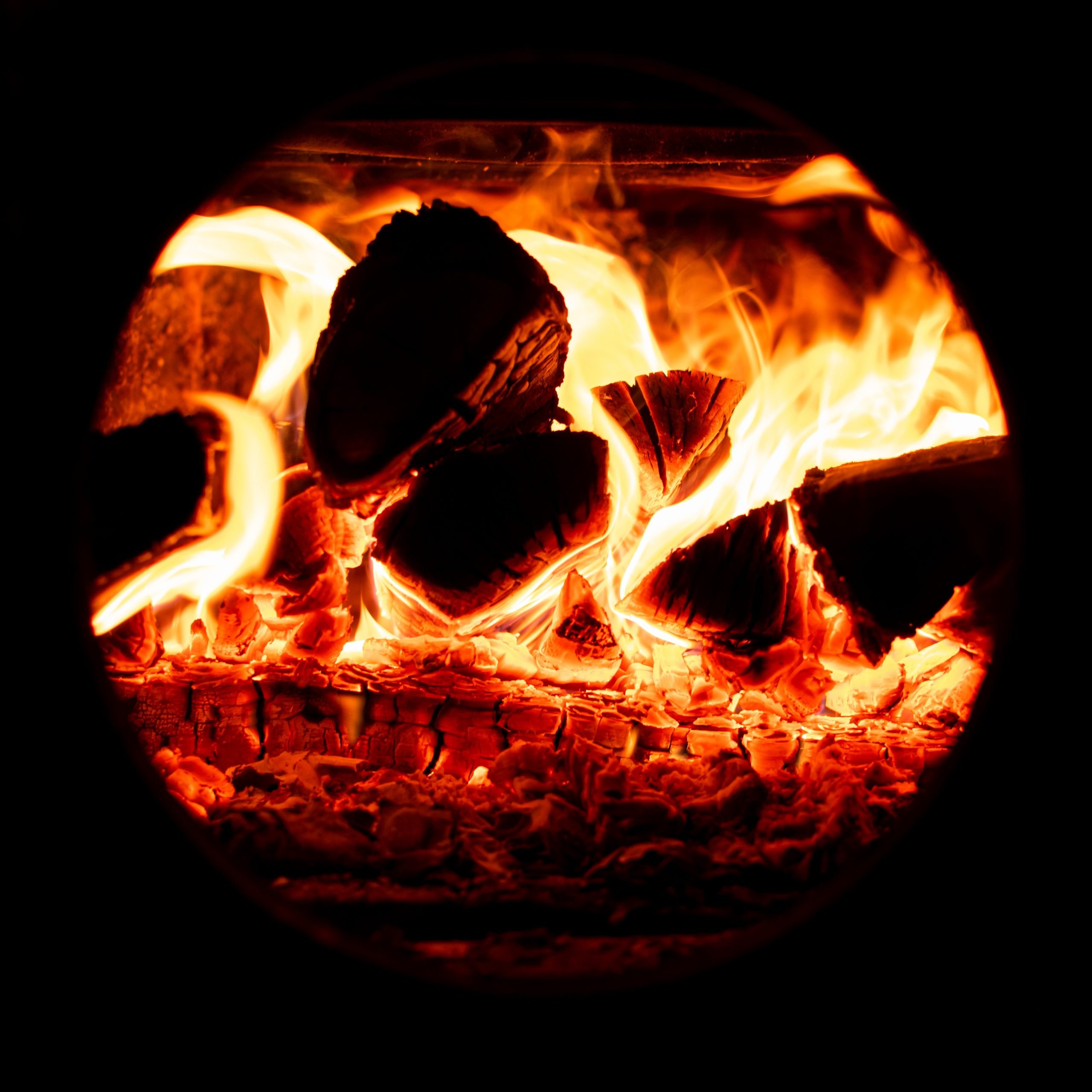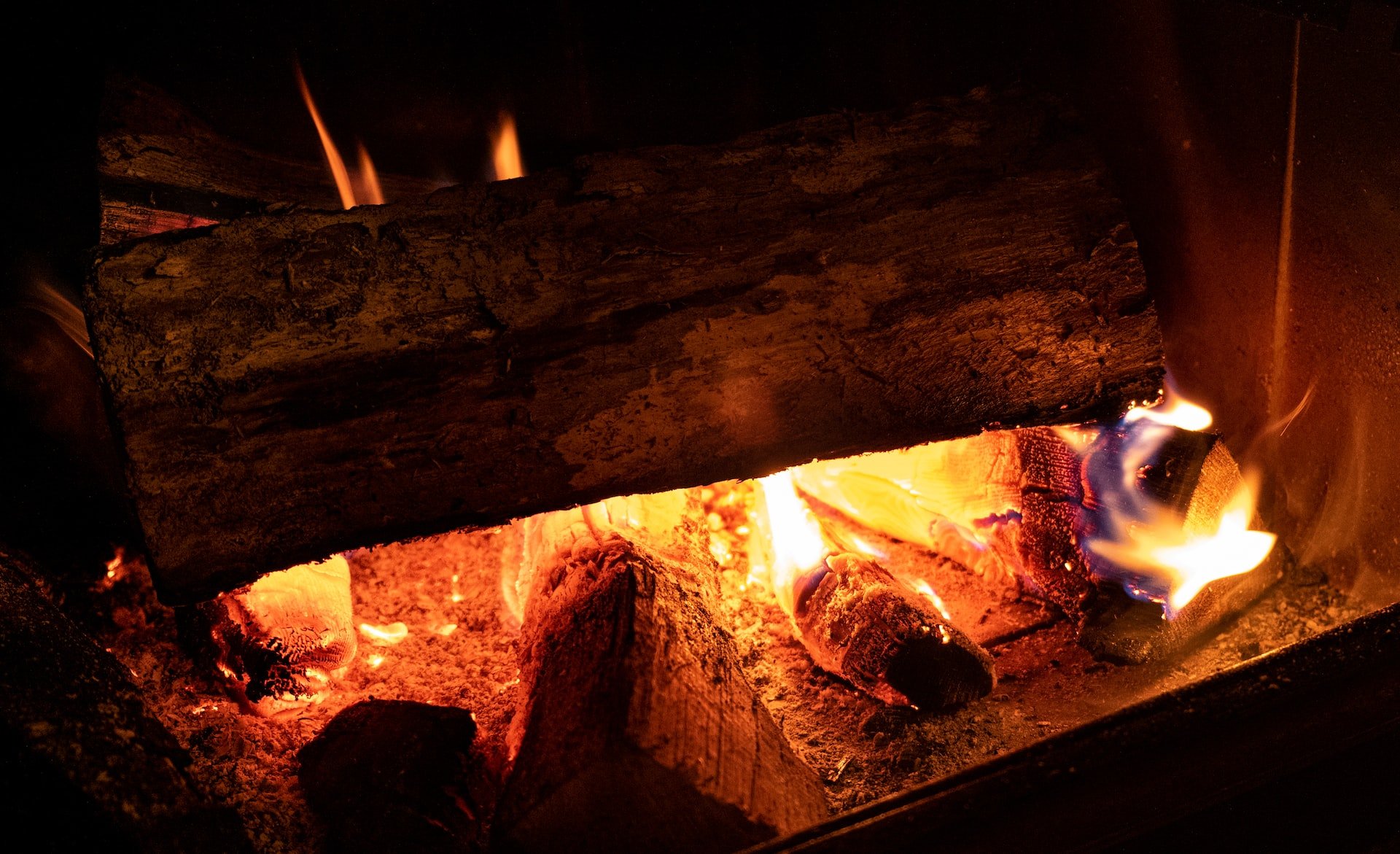5 Tips on How to Get More Heat Out of Your Wood-Burning Stove
The cost of heating a home continues to rise. That is why it is important to make the most of your log burner or wood-burning stove to minimise the money you spend on heating your home. The more heat you can get out of your wood burner, the less money you'll have to spend, and the less impact you'll have on the environment.
However, there is more to it than just feeding the fire to maximise the heat of your wood-burning stove. Continue reading to discover five things you can do to get more heat out of your wood-burning stove.

1. Make Sure Your Wood Is Dry
You know how frustrating it can be if you've tried to light a fire in a damp wood-burning stove. The wood won't catch, the fire goes out, and you're left shivering in the cold. Dry wood is essential for an excellent wood-burning fire. If you want to retain more heat from your wood-burning stove, ensure the wood you're using is dry.
2. Don’t Over-Fire Your Stove
Like most people, you probably think the more wood you burn in your stove, the more heat you'll generate. Unfortunately, that's not always the case. If you over-fire your stove, you could lose heat instead of retaining it.
When you over-fire your stove, the flames can become too hot, causing the stove to become less efficient. The heat from the fire can start to radiate out of the stove instead of being trapped inside. As a result, your stove will have to work harder to maintain the same heat level, and you'll end up using more wood than you would have if you'd just burned a moderate fire.
The best way is to start with a minor fire and add wood gradually, as needed. That way, you can avoid wasting wood and still generate enough heat to keep your home warm and comfortable.
3. Use a Stove Fan to Help Circulate the Heat
A stove fan can help you circulate the heat from your wood-burning stove and retain more heat in your home. Stove fans work by drawing in the warm air around the stove and spreading it throughout the room. It can help to even out the temperature in the room and make it more comfortable.
4. Don’t Open the Door Too Often
Heat escapes when you open the door to your wood-burning stove, and cool air rushes in. So, if you want to keep your home nice and warm, it's best to keep the door closed. There are a few exceptions to this rule, of course. For example, you'll need to open the door occasionally to add more wood to the fire. But try to keep the door shut to retain as much heat as possible.
5. Get Your Chimney Cleaned Regularly
A dirty chimney can cause your wood-burning stove to work less efficiently, meaning that you'll use more wood to generate the same amount of heat. In addition, a dirty chimney can be a fire hazard. A clean vent allows hot air to flow freely, making your stove work more efficiently.
Conclusion
Always make sure your stove is spotless and clear of any debris. A clean stove will produce less smoke and increase overall burning efficiency. When using the stove, you need to ensure the damper is open. It will enable the hot air to move around your property, which will help to heat it more evenly.
Are you looking for reliable wood-burning stove installers? Check out Stove Scotland! We provide different supply and installation packages tailored to your needs and budgets. In addition, we offer a comprehensive professional maintenance package so that you and your family can continue to enjoy your stove for many years to come. Contact us today to learn more!
4 Helpful Tips for Wood-Burning Stove Installation
When it comes to heating your home, there are a variety of different options to choose from. One of the most popular methods of heating a home is through the use of a wood-burning stove. If you are thinking of installing a wood-burning stove in your home, here are four tips to help you get started:

Choose the Right Location for Your Wood Burning Stove
When installing a wood-burning stove, it is important to choose the right location. The stove should be installed in an open area where there is plenty of room to move around. It should also be located near a door or window so you can easily bring in the firewood.
The stove should never be installed in a small, enclosed space, such as a bathroom or bedroom. Not only is this a safety hazard, but it can also cause the stove to overheat.
If you are installing the stove in a basement, make sure the floor is made of fire-resistant material, such as concrete. The stove should also be installed on a non-combustible surface, such as a concrete slab.
Inspect the Flue
Before installing a wood-burning stove, it is important to inspect the flue. The flue is the pipe that runs from the stove to the roof of your home. It is important to make sure that the flue is in good condition and is the right size for your stove.
Install Chimney Liner
If your flue is in poor condition, you may need to install a chimney liner. A chimney liner is a pipe that is installed inside the chimney. It helps to protect the chimney from the heat of the fire and prevents the formation of creosote.
There are a few different types of chimney liners that you can choose from. The most common type is the stainless steel liner. This type of liner is durable and can withstand high temperatures. Another type of liner is the ceramic liner. This type of liner is also durable and can withstand high temperatures. However, it is more expensive than the stainless steel liner.
Install a Stove Pipe
A stove pipe is a pipe that is installed between the stove and the chimney. It helps to distribute the heat from the stove and prevents the formation of creosote. The most important function of a stove pipe is to help distribute the heat from the stove. If the heat is not distributed properly, it can cause the stove to overheat and damage the stove. A stove pipe also helps to prevent the formation of creosote. Creosote is a black, tarry substance that can form on the inside of the chimney. If it is not removed, it can cause a chimney fire.
Conclusion
Following these four tips will help make the installation of your wood burning stove go more smoothly. By taking the time to properly prepare and plan for your stove installation, you can avoid many of the common problems and headaches that can occur during this process.
Are you looking to buy the best log-burning stoves in Scotland? Stove Scotland has got what you need! We will work with you to ensure that your stove will perfectly fit the style and dimensions of your room. Contact us today to learn more
Some of the Best Firewood Alternatives for a Stove
There are a number of unique objects that you may use as alternatives to traditional firewood. While firewood will always be the most preferred 'fuel' for stoves, there are times when you may run out of them, so there is no shame in using alternatives instead.
If you want to get creative during those emergency situations, look no further than our suggestions below.

1. Garden Trees and Shrubs
Whenever things got out of hand, many people turned to trees and shrubs in their yards and gardens as an alternative to power. It wasn't easy for those who didn't have a chainsaw or gas to power it, but neighbours cooperated by sharing tools, gas, and sometimes labour. Some people even traded firewood for help.
The main way to gather wood in the past was by using an axe or a handsaw. This was usually a daily chore, as wood was needed for many things. One issue with using mostly unseasoned, green wood was that it would burn quickly unless it was bundled tightly.
2. Rolled Paper Logs
Some people with a lot of paper created logs out of it by tightly rolling it up. The paper they used could be from anything like newsprint, magazines, books, and phonebooks to just regular garbage.
Some people simply sat down and rolled their paper logs by hand. Baling wire was sometimes used to bind the paper logs, but string, rubber bands, and anything else that would bind the paper tightly were used.
Paper logs are not as durable as wood logs, but they burn hotter and can help maintain heat in an emergency.
3. Lumber Scraps
Lots of people have wood leftovers from when they renovated their basements or put in new hardwood floors. These pieces are usually saved for small projects. But people affected by the ice storm used them to ensure their homes were safe.
One downside to using these types of wood is that they burn hot and fast, which can be a problem if you're using them in a fireplace. They also tend to spit and spark a lot, so you need to be careful if you're using them around a fireplace.
That said, a fireplace is not a very efficient way to heat a room because a lot of the heat produced by the fire goes up the chimney.
4. Damaged Furniture
We all have some old furniture in our homes that we don't use anymore. When a storm hits, people often throw these old desks and cabinets into the woodstove or fireplace. However, this wood often sparks and spits, and depending on the type of wood; it can burn quickly.
5. Rolled Rag-Logs
This method of creating a fire is very extreme and should only be used as a last resort. To create this fire, you will need to gather natural materials such as cotton or wool rags, twigs, and bark. Once you have these materials, you will need to tightly bind them together to create a log. Once you have your log, you will need to set it on fire. Be sure to only use this method as a last resort, as burning synthetic materials is just as bad as burning plastic.
Conclusion
Overall, there are a variety of firewood alternatives you can use for your stove. Some of the best are hardwood pellets, newspapers, online firewood delivery, and compost. It's important to select the right option for your needs and to research the best alternatives for your specific stove.
If you are looking for a company that provides multi-fuel stoves in Scotland, look no further than our high-quality selections here at Stove Scotland. We supply top brands such as Merlin, Aduro, Pod, Askgard, Termatec, and Burley and are confident that we can find the perfect stove for you. Call us today for more information about our stove selections and our installation process.
Why You Should Consider Getting a Stove Thermometer
A stove thermometer is a must-have kitchen gadget for anyone who loves to cook. It is a device placed on the stovetop to measure the stove's temperature. This is important because the stove's temperature needs to be monitored to ensure that food is cooked properly.

Prevents Your Stove from Running Too Cold
If your stove runs too cold, it can cause your food to be undercooked. This is why it is essential to use a stove thermometer. By placing the thermometer on the stovetop, you can monitor the stove's temperature and ensure that it is running at the proper temperature. This will help to ensure that your food is cooked properly.
Helps with Fuel Efficiency
A stove thermometer is an excellent way to help you be more fuel efficient when cooking. By monitoring the temperature of your stove, you can better control the amount of fuel you use.
A stove thermometer can help you save money on your fuel bill and help you cook more evenly. If your stove runs too hot, you can adjust the flame to use less fuel. Conversely, if your stove runs too cool, you can turn up the flame to use more fuel.
A stove thermometer is a simple and effective way to help you be more fuel efficient. By monitoring the temperature of your stove, you can better control the amount of fuel you use.
Allows You to Make the Most of Your Stove
A stove thermometer is an excellent way to ensure that your stove is operating at peak efficiency. By monitoring the temperature of your stove, you can make sure that it is running as efficiently as possible. Monitoring your stove's temperature will help to prolong the life of your stove.
There are a few things to keep in mind when using a stove thermometer. First, you need to place the thermometer in a location where it will not be disturbed by the heat of the stove. Second, you need to ensure that the thermometer is placed in a location where it can accurately measure the temperature of the stove.
The best place to put your stove thermometer is on the back of the stove. This way, the thermometer will not be affected by the heat of the stove, and it will be able to accurately measure the stove's temperature. You should also make sure that the thermometer is placed in a location where it is not in the way of the stove door.
Another thing to keep in mind when using a stove thermometer is to check the temperature regularly. This way, you can make sure that the stove is running at its optimal temperature. If the stove is not running at its optimal temperature, you may want to adjust the settings on the stove.
Final Thoughts
A stove thermometer is a really great way to ensure that your stove is operating at the correct temperature. By monitoring the temperature of your stove, you can make sure that your food is cooked evenly and efficiently. In addition, a stove thermometer can help you to save energy by ensuring that your stove is not set too high or too low.
Improve your cooking experience with the help of Stove Scotland. We are market experts with a comprehensive knowledge of stoves and fires that provide quality multi-fuel stoves in Scotland. We will work with you to ensure that your stove will perfectly fit the style and dimensions of your room. Get a free quote now!
9 Things to Consider before Installing a Wood Burning Stove
When it comes to wood-burning stoves, there are a few things you need to take into consideration before having one installed in your home. Here are seven things to keep in mind:
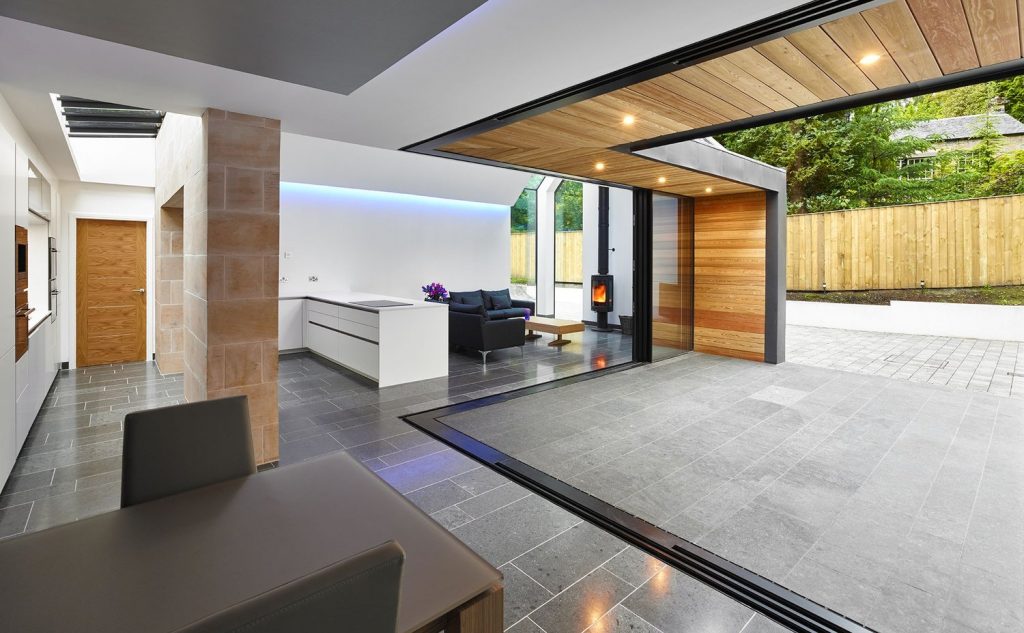
1. The Cost of the Stove and installation
Wood burning stoves can range in price from a few hundred pounds to several thousand, depending on the size and style of the stove. You will also need to factor in the cost of installation, which can be around £500 - £1500.
2. The Size of the Stove
The size of the stove you need will depend on the size of your home and how much heat you need to generate. A smaller stove will be sufficient for a single room, whereas a larger stove will be needed to heat a whole house.
3. The Location of the Stove
The location of the stove is important to consider as it needs to be situated in an area where there is good ventilation. It also needs to be close to a flue or chimney so that the smoke can be properly vented.
4. The Design of Your Chimney
If you don't already have a chimney, you will need to have one installed to have a wood-burning stove. The design of your chimney is important to ensure that the smoke can be properly vented.
5. Plan for Proper Wood Storage
You will need to have a good supply of wood to burn in your stove, so it is important to plan for proper storage. A shed or garage is a good place to store wood, as long as it is kept dry and away from damp areas.
6. Prepare for Regular Maintenance
Your wood-burning stove will need to be cleaned regularly, so you will need to have the proper tools on hand. A good quality chimney brush, gloves, and a ladder will be necessary.
7. Add Safe Flooring
If you have hardwood floors, you will want to ensure that they are protected from sparks and embers that could fall from the stove. Adding a rug or mat in front of the stove will help to protect your floors and keep them looking great.
8. Choose the Right Stove
There are many different types of wood-burning stoves on the market, so you will want to make sure that you choose the right one for your home.
Read reviews to find the best wood-burning stove for your needs, and make sure that you buy one that is the right size for your home.
9. Install a Carbon Monoxide Detector
It is very important to install a carbon monoxide detector near your wood-burning stove. This will help to alert you if there is a problem with the stove and will allow you to get to safety quickly.
Conclusion
There are a few things to consider before installing a wood-burning stove. First, you need to determine if your home is already set up for a wood stove. This means having a chimney or flue that is in good condition and able to vent the smoke from the stove. If you don't have a chimney, you can have a professional install one for you. Second, you need to make sure you have enough wood to burn. It's a good idea to have at least a cord of wood on hand, and it's even better if you can store it in a dry, sheltered place. Third, you need to be aware of the potential fire hazards associated with wood stoves. Make sure you have a fire extinguisher on hand and know how to use it. Lastly, enjoy your wood stove and the warmth it provides!
Are you looking for stove fitters in Scotland? Stove Scotland can help! Our team is composed of professional tradesmen who are all experts in installing stoves. We take a custom approach to each space, even if you don't have a chimney, so that you can achieve the wood burner stove of your dreams. Don't hesitate to contact our team today for a free quote!
How to Properly Care for Your Wood Stove
Now is the time to give your wood stove a good cleaning. This will help to ensure that it is ready to use for next season and that it will be safe to operate. But aside from cleaning. Your wood stove regularly, you want to ensure that you're giving it the care it needs.
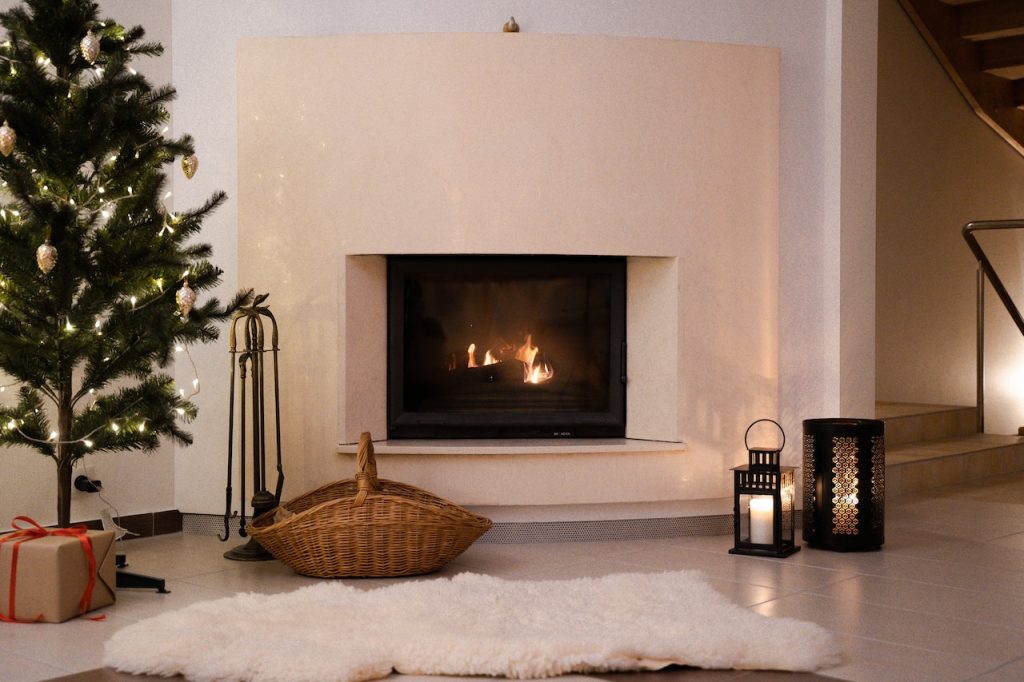
But how do you take care of your wood stove, anyway? Here are some tips for you:
Make Sure You Are Only Burning Wood
This may seem like a no-brainer, but you would be surprised at how many people make the mistake of burning other materials in their fireplaces or wood stoves.
Wood is the only material that should be burned in a fireplace or wood stove. Other materials, such as paper, cardboard, or even leaves, can catch fire and burn very quickly. You should also avoid burning trash, artificial logs, driftwood, and any material with sulfur, lead, plastics, or zinc.
Clean the Flue Thoroughly
When it comes to wood stoves, one of the most important things to keep in mind is that you need to clean the flue properly. This is because the flue helps draw the smoke and fumes up and out of the stove and into the chimney. If the flue is not clean, it can become clogged and cause problems with the stove itself.
There may be different ways that you can clean the flue. One is to use a wire brush and scrub the flue clean. Another option is to use a vacuum cleaner with a hose attachment to suck up any debris in the flue.
Either way, it is crucial to make sure that you clean the flue regularly to ensure that your wood stove is working correctly.
Choose the Right Fuel
To make the most out of your wood stove, you need to choose the right fuel. Softwoods such as pine and fir are great for getting a fire going, but they don't produce as much heat as hardwoods. Hardwoods like oak and maple burn slowly and steadily, giving you a long-lasting fire that will keep your home warm all night.
Ensure You Are Burning Fuel As Efficiently As Possible
There are some easy steps you should do to make sure you're burning fuel as efficiently as possible.
First, you want to ensure the wood you're using is dry. Wet wood doesn't burn as well and creates more smoke. You can tell if the wood is dry by looking for cracks in the ends of the logs - if they're present, the wood is likely to dry enough to use.
Next, you want to build a fire. This means using small pieces of wood at first to get the fire going and then adding larger pieces once the flames are high. You want to avoid putting too much wood on the fire at once, as this can cause the fire to smolder and produce a lot of smoke.
Finally, you want to ensure the damper on your wood stove is open. The damper regulates the amount of air that flows into the stove; if it's closed too much, it can smother the fire and make it difficult to get going.
Conclusion
Taking care of your wood stove in Scotland helps ensure that it will continue to operate efficiently and safely. A well-maintained wood stove will burn hotter and cleaner, producing less smoke and reducing the risk of a chimney fire. Regular cleaning and proper use of your wood stove will help to prolong its life and keep your home safe.
Stove Scotland is where you can get the finest wood stove in Scotland that will suit your needs. We carry some of the top brands that homeowners have trusted for years. Find out more about Stove Scotland's products and services today!
The Various Advantages of Using a Wood Burning Stove
Wood-burning stoves are self-contained heating appliances that use wood combustion to generate indoor heat. There are many different sizes and styles, but the fundamental principles remain the same.
The stove's body, which is usually made of steel or cast iron, contains a wood fire. The fire warms the stove's body, which radiates heat into the surrounding area. The smoke from the fire exits the structure via a passageway (called the flue) that leads to a chimney.
While they have taken the backstage due to the different heating technology available, there are various advantages to using a wood-burning stove. In this article, we will run you through the reasons why you should consider a wood stove.
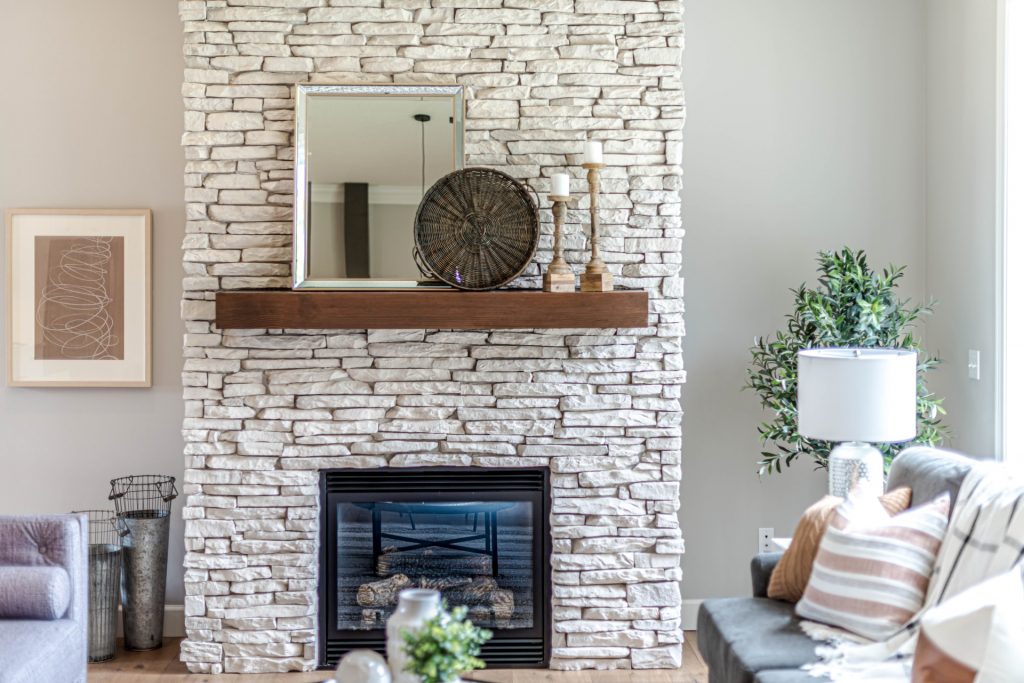
Beyond the Country Chic Aesthetic
Wood-burning stoves today come in a wide range of styles, from traditional pot-bellied country kitchen units to sleek, ultramodern contemporary models. Wood-burning stoves are also available in freestanding, corner, and built-in wall-mounted configurations.
Heating More Space
A wood stove on the main floor will also help heat a second floor because heat rises. Placing the stove in the room where you spend the most time can help you save up to 25% on fuel.
You may find whole-house wood-burning systems that can replace existing gas, oil, or electric heating systems to heat your entire home for less. They're also extremely modern, with features such as automatic wood hopper loading, automatic ignition switches, programmable timer settings, and remote controls.
Efficient Modern Models of Stoves
Earlier models of wood stoves were not known for their efficiency, but stove manufacturers have improved in recent years. When shopping, look for EPA-certified models that emit only two to seven grams of smoke per hour instead of the 15 to 30 grams per hour produced by old, uncertified stoves.
Saving on Energy Usage
Four cubic metres of adequately seasoned hardwood generates heat equivalent to approximately 590 litres of fuel oil. Wood is a renewable resource, and trees grown in your area can help your local economy.
Added Safety Features
Since the 1980s, wood stoves have become safer than ever. This is due not only to the new appliance and part standards but also to training and certification programs for people who sell and install wood stoves. They'll assist you in ensuring that your stove is installed correctly, with a proper hearth underneath to protect your floor.
Reliability
One of the most unpleasant aspects of severe winter weather (aside from having to dig your way out) is the possibility of losing power. That's where a wood stove comes in handy, keeping your home toasty warm and providing a place to cook a meal even when the rest of your appliances are broken.
Airflow Control
If you already have a wood-burning fireplace in your home, you can buy a fireplace insert to convert it from a purely decorative hearth to a functional wood stove. These insert kits close off the fireplace and allow you to control airflow like a wood-burning stove.
Functionality
You can find modern wood stove units that can be connected to water heaters or radiators for even more energy savings. A growing online community of resourceful home hackers can assist you in safely DIYing your solution.
Conclusion
Wood stoves are a great way to heat your home. They are efficient and can save you money on your heating bill. They are also environmentally friendly and can help you reduce your carbon footprint.
Are you looking for a wood stove in Scotland? Stove Scotland has experts with comprehensive knowledge of stoves and fires to ensure you get the perfect wood and multi-fuel burning stoves. Get a free quote today!
How to Ensure That Wood Burning Stoves Are Safe to Use
There's something special and romantic about a wood burning stove that you can't get from central heating. That's why, even though central heating has been around for a long time, stoves are still popular in British homes.
Aside from that, using wood as a heat source is a sustainable way to reduce your carbon footprint.
While wood burning stoves are often seen as a more environmentally friendly option, they are actually responsible for 38% of the UK's primary emissions of harmful particulate matter (PM) and sulphur dioxide.
The government's goal is to ensure that only the cleanest stoves are available for homeowners to buy by 2022. In January 2019, the government introduced legislation to encourage the sale of safer wood burning stoves.
But how do you ensure that your wood burning stove is safe for your home and the environment? Here are some things you should consider.
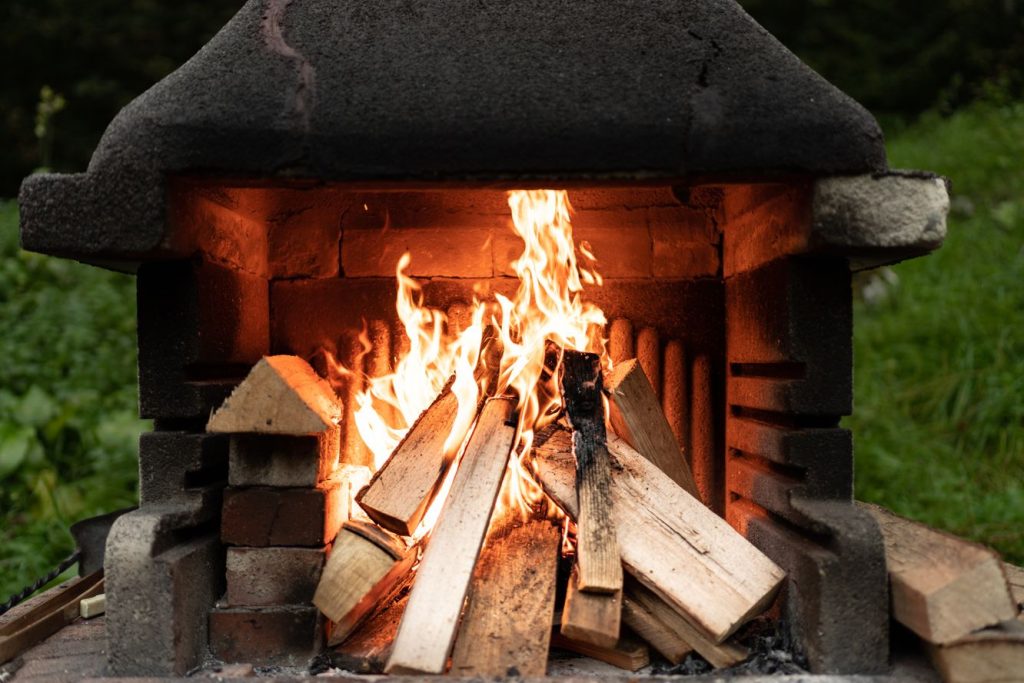
Using Ecodesign Ready Appliance
Ecodesign ready stoves are the newest generation of ecofriendly stoves. Advanced flue systems allow these stoves to channel airflow into creating more thorough and fasterburning combustion. This results in less pollution and a cleaner burning process overall. Not only does this make for a healthier home environment, but it also helps save on fuel costs in the long run.
The Clean Air Strategy is a set of guidelines introduced by the UK government in 2018 to reduce the number of harmful particulates released into the atmosphere. As part of the strategy, the government has placed stricter regulations on manufacturing and selling wood burning stoves. These changes have resulted in a shakeup of the wood burning stove industry, with many manufacturers adapting their products to meet the new standards.
The goal of SIA, together with DEFRA, is that by 2022, the only wood burners available to purchase in the UK will be those that meet the Ecodesign Ready standards. These standards are designed to ensure that wood burners are as efficient and clean burning as possible to help reduce emissions and improve air quality.
Burning the Right Fuel
The type of fuel you burn in your stove makes a big difference in the safety and emissions of your stove. The best type of wood to burn is dry, well-seasoned hardwood.
Hardwoods, such as oak and ash, have a lower moisture content and produce less smoke than softwoods. They also produce more heat and last longer when burning.
If you must burn softwood, make sure it's been adequately seasoned so it doesn't produce too much smoke. You can tell if the wood is properly seasoned if it's:
- Light in weight
- Has cracks on the ends or sides (called "checking")
- Splits easily when bent
- With less than 20% moisture content
The moisture content of logs is vital because waterlogged wood releases significantly more smoke and harmful gases into the air than dry wood. This can cause serious health problems for you and your family and damage your home.
The UK's Department for Environment, Food & Rural Affairs (DEFRA) recommends using fuel certified by Woodsure as "Ready to Burn." This certification means the timber bag has less than 20% water content. Alternatively, you can check the moisture content of your firewood with a moisture meter before burning it.
Conclusion
Wood burning stoves are a popular and environmentally friendly heating option, but they can pose a risk if not used properly. Ensuring that your wood burning stove is safe is important for your home and the environment. By following these guidelines, you can be sure that your wood burning stove is safe for your home and the environment.
If you're looking for an environmentally friendly and comfortable way to heat your home, a wood burning stove is a great option. At Stove Scotland, we supply, install and maintain wood burning stoves that are designed with safety in mind. We also offer installation packages to make it easy for you to get your new stove set up in no time. Let us help you choose the perfect stove for your home! Contact us today to get started!
5 Uncommon Yet Fascinating Uses for Wood Ash You Must Know
Wood ash is the remaining powdery substance left behind after the combustion of wood. It is generally composed of calcium oxide and other minerals that are extracted from the wood during the burning process. While most people would think to simply throw wood ash away, it's not actually completely useless. On the contrary, wood ash can have some fascinating uses that you may be interested in trying.
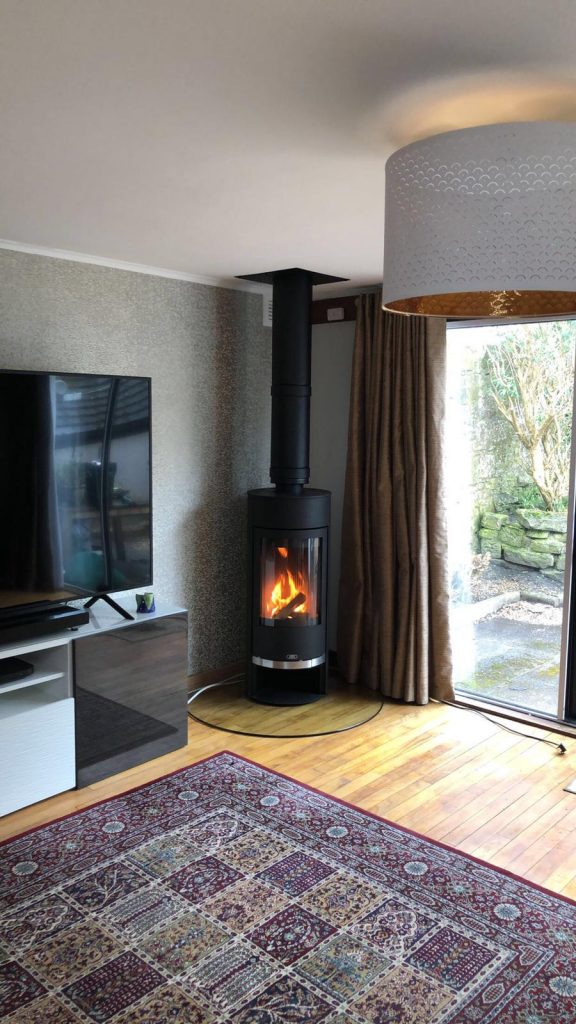
1. Teeth Whitening
Wood ash is often used as a natural teeth whitening agent. The high concentration of calcium in wood ash helps to remove any unwanted stains on your teeth while also providing a gentle abrasive action that can help to scrub away any plaque or tartar buildup. To use wood ash as a teeth whitener, simply wet your toothbrush and dip it into the wood ash. Gently brush your teeth as you would normally, and then rinse your mouth thoroughly with water.
2. Soil Amendment
Wood ash can also be used as a soil amendment to improve the overall quality of your garden soil. The calcium in wood ash helps to improve drainage and aeration while also providing essential nutrients that can help plants to grow more vigorously. Wood ash can also help to neutralize the soil pH, making it more hospitable for plants that prefer a neutral or slightly alkaline environment. To use wood ash as a soil amendment, simply spread it evenly over the surface of your garden soil and then work it in with a garden tiller or spade.
3. Pest Repellent
Wood ash can also be used as a natural pest repellent. The high concentration of calcium in wood ash helps to deter many common household pests such as ants, cockroaches, and silverfish. To use wood ash as a pest repellent, simply sprinkle it around the perimeter of your home or garden. You can also sprinkle wood ash around the base of trees and shrubs to help deter rabbits and other small mammals from eating the plants.
4. Ice Melt
When the winter weather hits, wood ash can be used in place of salt or other ice melt products. Wood ash works by lowering the freezing point of water, which helps to prevent ice and snow from forming. To use wood ash as an ice melt, simply sprinkle it over icy areas. You can also mix wood ash with salt to create a more effective ice melt.
5. Pottery
Pottery is another great use for wood ash. When mixed with water, wood ash can be used to create a glaze for pottery. This glaze can give pottery a unique, rustic look. To use wood ash to glaze pottery, simply mix it with water to form a paste. Then, apply the paste to the pottery and bake it in the oven.
Final Thoughts
As you can see, there are many different ways to use wood ash. Whether you’re looking for a natural way to fertilize your plants or you’re trying to create a unique glaze for your pottery, wood ash can be a great option. So, the next time you have some wood ash on hand, don’t throw it away. Instead, put it to good use.
Get a quality wood stove in Scotland from Stove Scotland. Our priority is to provide you with a professional, honest and reliable service at an affordable price. As market experts with a comprehensive knowledge of stoves and fires, we will work with you to ensure that your stove will perfectly fit the style and dimensions of your room. Get a free quote now!
5 Reasons Why You Should Invest in a Multifuel Stove
A multifuel stove is a great option if you want the flexibility to use different types of fuel. Whether you want to burn logs or coal, these stoves are designed to handle it. They're also very popular with our customers.
There are three main types of stove: log burners, multi-fuel stoves and wood pellet stoves. Log burners burn logs, multi-fuel stoves can burn both logs and other solid fuels, and wood pellet stoves burn wood pellets.
But why are multifuel stoves becoming more popular? Here are some of the biggest reasons why.

1) They Are Self-Reliant
Multifuel stoves are an excellent option for people who live in areas where power outages are common during the winter. These stoves do not require any type of external power source, so you can rely on them even when the electricity is out. They can be used to heat your home or cook food, and they are relatively inexpensive to purchase and operate.
If you are looking for a way to keep your home warm during a power outage, or if you simply want a stove that you can use in case of an emergency, then a multifuel stove is a great option.
2) They Consume Low Energy
A multifuel stove is a stove that can burn more than one type of fuel. This is a great way to save on energy bills because you only have to purchase the fuel and there are no other overheads. Plus, you won't have to worry about receiving unexpectedly high energy bills.
If you are using your stove to generate heat, it is important to be aware of how much energy it is consuming.
3) They Are Efficient and Effective
Multifuel stoves have been designed to burn several different fuels from eco-friendly solid fuels for use in areas that have strict rules regarding smoke emissions, to wooden logs or coal.
This means that you can choose the fuel that is best suited to your needs, whether you are looking for an environmentally friendly option or something that will give you a longer and hotter burn.
4) They Are Easy to Clean and Maintain
A multifuel stove is easy to clean and maintain. The stove does not need to be vented, and there is no need to worry about ashes or soot.
The ash pan on a multifuel stove makes it easy to clean the stove. The ash pan collects all the ash and debris, making it safe to dispose of. The ash pan also prevents blockages and gives you years of trouble-free heat.
5) They Are Aesthetically Pleasing
A wood-burning stove is a beautiful addition to your home. They are an excellent way to create a cosy atmosphere, and how better to do that than with the crackle of a real log fire?
Aesthetics are not just about the look of the stove; it’s also about the smell. The smell of a wood-burning stove and the scent of the wood smoke is one of the most relaxing smells in the world.
Conclusion
There are many reasons for choosing a wood-burning stove for your home. The main reason is that you will get warmth and comfort from your stove.
If you want to try multifuel stoves for yourself, Stove Scotland has you covered. We are trusted stoves installers that will help you experience the benefits for yourself. Get in touch with us today to learn how.

